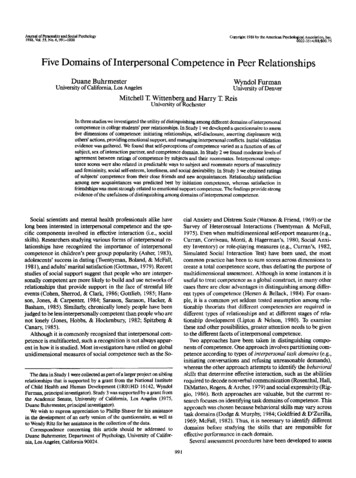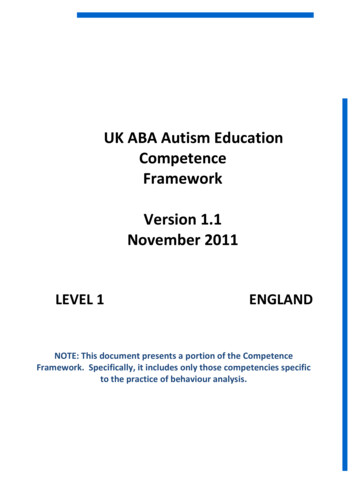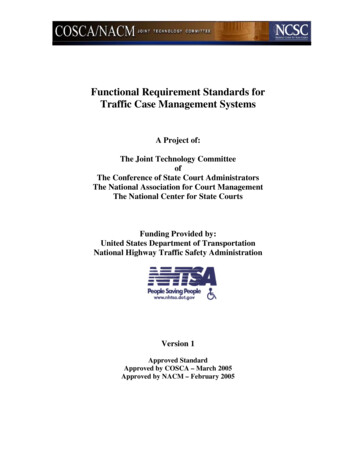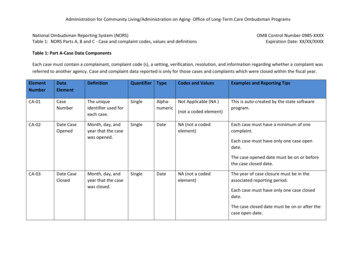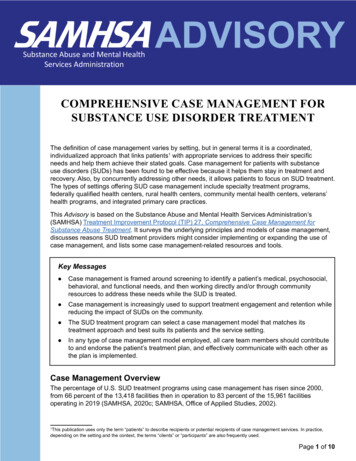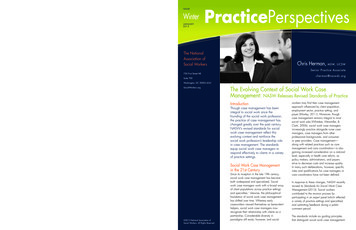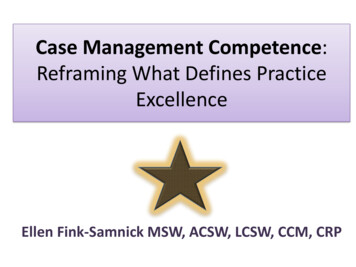
Transcription
Case Management Competence:Reframing What Defines PracticeExcellenceEllen Fink-Samnick MSW, ACSW, LCSW, CCM, CRP
That 64 Million Dollar QuestionWho makes thebest casemanager? Can Stock Photo / OstillEFS Supervision Strategies, LLC 2020
Learning Objectives Define what competencies comprise a strongcase management candidate Delineate between hard and softcompetencies Distinguish case management teamcompetencies Discuss performance management and itsvalue to defining case managementcompetenceEFS Supervision Strategies, LLC 2020
Disclosure & DisclaimerThere are no potential conflicts of interestcontained in the information provided inthis presentation. All material is the opinionof this presenter or cited to source and/orauthorityAny products referred to during thispresentation are for the sole purpose ofexample only and should not be taken asproduct endorsement.EFS Supervision Strategies, LLC 2020
Continuing EducationThis program has been pre-approved by TheCommission for Case Manager Certification toprovide continuing education credit to CCM board certified case managers.EFS Supervision Strategies, LLC 2020
CMWHAT IS CASE MANAGEMENTCOMPETENCE?EFS Supervision Strategies, LLC 2020
Definition‘A person thought to havethe necessary ability orskills, or is able to dosomething well enough tomeet a standard’(Merriam-Webster, 2018) Can Stock Photo / andose24EFS Supervision Strategies, LLC 2020
Definition‘A set of defined behaviorsthat provide a structuredguide enabling theidentification, evaluation,and development of thebehaviors in individualemployees’(Lundberg, 1972) Can Stock Photo / iDesignEFS Supervision Strategies, LLC 2020
DefinitionOccupational Competency Different competencies predictperformance excellence indifferent roles. a ‘competency’ for one job isnot consistent across all roles. Can Stock Photo / iDesign(McClellan, 1973)EFS Supervision Strategies, LLC 2020
Definition and Evolution199519972000 Joint Commissionrequires hospitalsassess, prove, track &improve competenceof employees Hard & SoftCompetenciesemerge Competencies:determination of aperson’s capacity toperform a jobfunction to definedexpectation.EFS Supervision Strategies, LLC 2020
HardCompetenciesDefinition and Evolution Specific jobrelatedqualifications FunctionsCompetentProfessionalSoftCompetencies Personalitytraits Individual style(Parsons and Capka, 1997)EFS Supervision Strategies, LLC 2020
Definition and EvolutionWork ininterprofessionalteamsHealth & Medicine Division(HMD):Core Competencies (2003)Provide patientcentered Apply qualityimprovementEFS Supervision Strategies, LLC 2020
Meanwhile: Teamwork Evolution of Competency(Treiger and Fink-Samnick, linaryMultidisciplinary Small workgroup for a patient or group ofpatients Collective identity, and Shared decision making Assessment completed together byseveral disciplines Co-treatment as clinically indicated Integrated goal-setting shared Consistent communication Coordinated group ofexperts of different fields High levels communication& collaboration Group of memberswith varied expertise Common focus Limitedcommunication
Definition and EvolutionInterprofessionalEducationCollaborative (2010)CompetencyDomain 4:Teams andTeamworkCompetencyDomain 3:InterprofessionalCommunicationCompetencyDomain 1:Values/Ethics forInterprofessionalPracticeCompetency Domain2:Roles/ResponsibilitiesTo prepare health professions students for deliberatively working together, with thecommon aim of building a safer & better patient-centered and population orientedU.S. health care systemEFS Supervision Strategies, LLC 2020
Competencies are a key factor of the quality health careequation They:– Set the tone for academic and professional accreditation– Guide job descriptions by inclusion of competency-based skills andpractice behaviors.‘Amid our fluid industry, competencies are that constant by whichorganizational return on investment is measured and validated.’ Can Stock Photo / aquir
‘These times beg for Professional CaseManagement to have clearly delineatedcompetencies that speak to its unique practicescope,otherwise the power & intent of our practiceremains the best kept secret.’ Can Stock Photo / aquir
A Distinction Competency and Skill both identify anability acquired through training andexperience. Skill refers to specific learned abilitiesneeded to perform a job; the ‘what’ Competencies are the ‘how’Skills knowledge abilities Competencies Can Stock Photo / stuartmilesEFS Supervision Strategies, LLC 2020
One More DistinctionJob Functions: The basicduties, tasks, or activities anemployee is responsible for ina particular role: Vary across roles Reflect the unique needs ofa particular population Coordinate team rounds Complete monthlyoutcomes Manage family meetings Complete clientassessments Provide psychosocialsupport Assure facilitation of safedischarge plans Negotiate out of contract orout of network agreementsEFS Supervision Strategies, LLC 2020
What Competencies Matter?EFS Supervision Strategies, LLC 2020
What Competencies Matter?(Wu, Martin, and Ni, 2017)10. Critical Thinking: 18%9. Communication: 18%8. Assessment: 18%7. Medical/health science knowledge: 27%6. Intervention: 27%5. Patient-care: 36%4. Leadership: 36%3. Management: 45%2. Scholarship and Research: 55%1. Professionalism and Ethics: 73%EFS Supervision Strategies, LLC 2020
12 Core Competencies For Successful JobPerformance (Penny, 2018)12. Stress tolerance11. Initiative10. Integrity9. Communication8. Planning and Organizing7. Adaptability6. Problem Solving5. Reliability4. Motivation3. Work standards2. Teamwork1. Decision makingEFS Supervision Strategies, LLC 2020
CMINTEGRAL COMPETENCIES FORPROFESSIONAL CASE MANAGEMENTEFS Supervision Strategies, LLC 2020
The COLLABORATE Paradigm(Treiger and Fink-Samnick, 2016)Critical ThinkingEthical legalOutcomes DrivenTransdisciplinaryLife long learningAnticipatoryLeadershipResource AwarenessOrganizedAdvocacyBig picture orientationEFS Supervision Strategies, LLC 2020
CompetencyKey ElementsCritical thinkingOut of the box creativityAnalyticalMethodical approachOutcome-drivenPatient outcomesStrategic goal settingEvidence-based practiceLife-long learningValuing:Academia/advanced degreesProfessional developmentEvolution of knowledgePracticing at top of licensure &/or certificationRecognizing no one case manager knows allLeadershipProfessional identitySelf-awarenessProfessional communication-verbal/non-verbalTeam coordinator: unifier rather than dividerAdvocacyClientFamilyProfessionalEFS Supervision Strategies, LLC 2020
CompetencyKey elementsBig picture orientationBio-Psycho-Social-Spiritual AssessmentMacro (Policy) impact on Micro eResource awarenessUtilization/resource managementCondition/Population-specificManagement of expectations per settingAnticipatoryForward thinkingProactive vs. reactive Professional DisciplinesAcross TeamsAcross the strative StandardsOrganizational Policies and ProceduresEthical Codes of ConductEFS Supervision Strategies, LLC 2020
Case Management’sCompetencies of Ethical Excellence (Fink-Samnick, 2019)CompetenceConfidentialityConflict ofInterestDishonestyDualRelationshipsDue DiligenceEFS Supervision Strategies, LLC 2020
CMHOW IS CASE MANAGEMENTCOMPETENCE MEASURED?EFS Supervision Strategies, LLC 2020
How is Case Management CompetenceMeasured? GoalsObjectivesOutcomes FinancialReturn on Investment Can Stock Photo / donskarpoEFS Supervision Strategies, LLC 2020
Goals and ObjectivesObjective2Objective1Goal Goals: Observable andmeasurable end resultswith one or moreobjectives to be achievedin a fixed timeframeObjective Objectives: Specific3results that a person orsystem aims to achievewithin a timeframe (AKA:finite steps to reach thegoals)EFS Supervision Strategies, LLC 2020
Goals and ObjectivesGoals should:1. Clearly define the end results tobe accomplished,2. Have direct & obvious linkage toorganizational factors or goals,3. Be difficult, but achievable, tomotivate performance,4. Be set in no more than threeareasTrying to achieve too many goalssimultaneously obstructs successEFS Supervision Strategies, LLC 2020
Sound Objectives Indicators Goals Solid Outcomes Indicator: HOW the objective is measuredEffective communication byCM with patient &/orcaregiver demonstrated by: Documentation ofencounter Reduced variancescaused bymiscommunicationEffective communication byCM with interprofessionalteam demonstrated by: Documentation ofencounter Reduced variances causedby miscommunicationObjectives & Indicators(Treiger & Fink-Samnick, tal hips &knees)GoalEFS Supervision Strategies, LLC 2020 Improvedmanagementbundlereadmissionsevidenced by 5%reductionmiscommunicationincidentsOutcome
CMIMPLEMENTING A COMPETENCY BASEDCASE MANAGEMENT APPROACHEFS Supervision Strategies, LLC 2020
Step 1: Integrate a Performance ManagementStructure that Names CompetenciesPrerequisitesPerformanceRenewal rformanceExecutionPerformanceAssessmentEFS Supervision Strategies, LLC 2018 33(Aguinis, 2013; Treiger & Fink-Samnick, 2016)
Step 2: Build a competence framework1. Select competencies:–Define those competenciesrelevant for your team2. Leverage themconsistently across:– Job descriptions– Performance metrics– Performance appraisals Can Stock Photo / iqonceptEFS Supervision Strategies, LLC 2018 34
Step 3: Use a Competencies Proficiency ScaleCompetencies Proficiency Scale1. Fundamental awareness (basicknowledge)2. Novice (limited experience)3. Intermediate (practical application)4. Advanced (applied theory)5. Expert (recognized authority)(NIH, 2018) Can Stock Photo / iqonceptEFS Supervision Strategies, LLC 2018 35
Step 3: Use a Competencies Proficiency Scale Fundamental awareness Novice Intermediate ExpertCritical ThinkingThe Case manager will: Engage in team meetings Address teamfragmentation/dissension Participate in developing teamintegration action plan Lead team integrationinitiativeEFS Supervision Strategies, LLC 2020
Step 4: Use a Clearly Defined PM ApproachDevelop competence-based job descriptions & employeeperformance plans.Select right employees by implementing appropriate vettingprocess.Negotiate requirements & performance standards tomeasure overall productivity against predefined benchmarks.Provide continuous coaching & feedbackHave a clear plan for developing ongoing continuingeducation/training needsEFS Supervision Strategies, LLC 2020
Step 4: Use a Clearly Defined PM ApproachDesign effective compensation and reward systems torecognize employees who excel in their jobs (e.g., achieve set standards in sync with performanceplans, exceed dept. performance benchmarks)Provide career development support and guidance toemployees.Perform exit interviews to understand why employeesleave the organization.EFS Supervision Strategies, LLC 2020
Step 5: Define Levels of AccountabilityEmployeeCommitment to goal achievementContinuous feedback & coachingSupervisor/ManagerOngoing observation, evaluation, &documentationActive involvement without enablingCommunication with direct supervisor Mechanism for feedbackCollect & share performance dataMutual prep for performanceappraisalsProvide resourcesReinforcement, validation(Adapted from Grote, 1996 in Aquinis, 2013 for Treiger & Fink-Samnick, 2016)EFS Supervision Strategies, LLC 2020
Step 6: Use Established Resources ofAccountability Use language of professional standards and codesEFS Supervision Strategies, LLC 2020
Case management is a collaborative process ofassessment, planning, facilitation, care coordination,evaluation, & advocacy for options and services tomeet an individual’s and family’s comprehensive healthneeds through communication & available resources topromote patient safety, quality of care, & cost-effectiveoutcomes(CMSA, 2016)EFS Supervision Strategies, LLC 2020
A. Client Selection Processfor Professional CaseManagement ServicesB. Client AssessmentC. Care Needs &OpportunitiesIdentificationD. PlanningE. MonitoringF. OutcomesG. Closure of ProfessionalCase ManagementServicesH. Facilitation,Coordination, &CollaborationI.Qualifications for Professional CaseManagersLegalJ.1.2.K.Confidentiality & Client PrivacyConsent for Professional Case ManagementServicesEthicsI.J.L.M.N.O.Primary obligation to clients servedSecondary obligation of engagement in andmaintenance of respectful relationship withcoworkers, employers & other professionals.AdvocacyCultural CompetenceResource Management & StewardshipProfessional Responsibilities & ScholarshipEFS Supervision Strategies, LLC 2020
PrinciplesBoard Certified Case Managers will:– Principle 2: respect the rightsand inherent dignity of client– Principle 5: maintain theircompetency at a level thatensures their clients will receiveUnderlying Values:the highest quality of serviceBoard Certified Case Managers: Understand and commit to quality– Principle 7: obey all laws andoutcomes for clients, appropriateregulationsuse of resources, and theempowerment of clients in amanner that is supportive andobjective Understand that case managementis a guide to the principles ofautonomy, beneficence,nonmaleficence, justice, and fidelityEFS Supervision Strategies, LLC 2020
Disclaimer‘The greatest danger in times of turbulence isnot the turbulence-–it is to act with yesterday’slogic.’—Peter Drucker Can Stock Photo / deeafEFS Supervision Strategies, LLC 2020
ThankyouContact topbullyingEllen Fink-Samnick MSW, ACSW, LCSW, CCM, CRPPrincipal, EFS Supervision Strategies, me.comEFS Supervision Strategies, LLC 2020
Can Stock Photo / payphotoEFS Supervision Strategies, LLC 2020
CMREFERENCESEFS Supervision Strategies, LLC 2020
Aguinis, H. (2013) Performance Management (third edition) PearsonEducation, LTD. Case Management Society of America (2016). Standards of practice for casemanagement . Little Rock, AK: Author. Commission for Case Manager Certification (2015). Code of professionalconduct for case managers with standards, rules, procedures, and penalties.Mount Laurel, NJ: Author. Fink-Samnick, E. (2017) . Case Management Competence: Reframing WhatDefines Case Management Practice Excellence, The HeartBeat of CaseManagement, Professional Case Management Journal, 22(4) WoltersKluwer, pg. 181-184 Fink-Samnick, E. (2019) The Essential Guide to Interprofessional Ethics inHealthcare Case Management, HcPro: Middleton, MA Grote, D. (1996) in Aguinis, H. (2013). Performance management (3rd ed.).Upper Saddle River, NJ: Pearson Education. Lundberg, C.C. (1972) Planning the Executive Development Program.California Management Review; 15(1), pg. 10-15 McClelland, D. (1973) Testing for Competence Rather Than Intelligence.American Psychologist, 28(1),pg. 1-14EFS Supervision Strategies, LLC 2020
Merriam-Webster (2018) Competent, retrieved February 22, 2018 petentMorrison , M. ( 2010 ). History of SMART objectives, Retrieved December 26, 2016,from onal Institutes of Health (2018) Competencies Proficiency Scale, RetrievedFebruary 27, 2018 from ncies-proficiency-scalePenny, J. (2018) What are the 12 Core Competencies, Best Job Interviews.com,Retrieved February 26, 2018 from cies.htmlTreiger, T., & Fink-Samnick, E. (2016). COLLABORATE for professional casemanagement: A universal competency based paradigm (1st ed.). Philadelphia, PA:Wolters Kluwer Health.Treiger, T. & Fink-Samnick, E (2017) COLLABORATE , Part IV: Ramping UpCompetency-Based Performance Management, Professional Case Management,22(3): 101-115Wu, W., Martin, B. C, & Ni, C. (2017). A systematic review of competency-basededucation effort in the health professions: Seeking order out of chaos. In K.Rasmussen, P. Northrup, & R. Colson. (Eds.), Handbook on research on competencybased education in university settings (pp. 352 – 378). Hershey, PA: IGI Global.EFS Supervision Strategies, LLC 2020
Aguinis, H. (2013) Performance Management (third edition) Pearson Education, LTD. Case Management Society of America (2016). Standards of practice for case management . Little Rock, AK: Author. Commission for Case Manager Certification (2015). Code of professional conduct for case managers with standards, rules, procedures, and .



